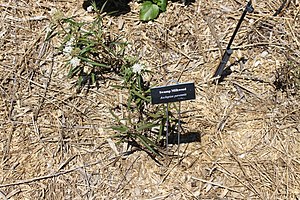Asclepias perennis
| Asclepias perennis | ||||||||||||
|---|---|---|---|---|---|---|---|---|---|---|---|---|

Asclepias perennis |
||||||||||||
| Systematics | ||||||||||||
|
||||||||||||
| Scientific name | ||||||||||||
| Asclepias perennis | ||||||||||||
| Walter |
Asclepias perennis (English (White) Swamp Milkweed , Aquatic Milkweed or Shore Milkweed ) is a species of the genus silk plants ( Asclepias ) from the subfamily of the silk plants (Asclepiadoideae).
features
Vegetative characteristics
Asclepias perennis is a perennial , herbaceous plant with a short, near-surface, partially woody rhizome. The slender, upright to ascending stems are 30 to 50 cm high; they usually only branch at the base above the rhizome. They are light green to reddish green and usually finely hairy in the upper half of the stem, the down in lines from the leaf axils. The lower part of the stalk, on the other hand, is almost completely bare. The thin-skinned, bare leaves are arranged opposite each other and have only a short stalk. The leaf blades are elongated-narrow, elliptical-lanceolate to broadly ovate and broadly elliptical, with a pointed apex, 5 to 14 cm long and 0.5 to 1.5 cm wide. The base is wedge-shaped to pointed. The leaf stalks are 0.5 to 1.5 cm long and have a longitudinal furrow on the upper side. The stems and leaves contain a whitish milky sap.
Inflorescence and flowers
The multi-flowered to multi-flowered inflorescences sit individually and upright in the uppermost leaf axils. Each inflorescence contains 20 to 50 flowers. The top of the umbel-shaped inflorescences is flat, the diameter is 4.5 to 6.5 cm. The shafts of the inflorescences are rather slender, and 1 to 4 cm long. The individual flower stalks are 10 to 13 mm long, often tinged slightly reddish or purple. The five-fold flowers with a double perimeter are hermaphroditic and zygomorphic . The wheel-shaped flowers are rather small with a diameter of about 6 mm. The blue-green to pale red-green flower stalks are about 2 to 3 cm long, round in cross-section and finely hairy. The sepals oblong-elliptical and about 1 mm long, and sparsely finely tomentose. The petal lobes are 3 to 4 mm long and strongly bent back. They are white with a pale purple tint, the tips are pink in color. Even the flowers that have not yet opened have a large pink spot in the middle. The secondary crown with the gynostegium is pedunculated. The stem is cylindrical and about 1 mm high and also about 1 mm thick. The shovel-shaped secondary petals are about 2 mm long and rounded at the top. They are therefore only less longer than the stylus head. The horn-shaped secondary processes are thin-needle-shaped and slightly longer than the hood-shaped secondary petals. They bend in over the stylus head. The flowers smell faint.
Fruits and seeds
The follicles, which are often paired, are initially upright, later they hang down on bent stems. They are thick spindle-shaped with a beak-shaped apex. The dimensions are: 4 to 7 cm long, 1 to 2.5 cm thick. The surface is smooth and hairless. The seeds are broadly ovate with widened edges and 1.5 mm long. You have no head of hair. When the follicles are ripe and open, they often fall into the water. They can float on the water surface for some time.
Geographical distribution and ecology
The distribution area of the species extends from South Carolina to Florida and in the west to eastern Texas and the Mississippi Valley up to Missouri , Illinois and southwestern Indiana .
It occurs there in or on the edge of marshy terrain along the rivers and river deltas, often with bald cypress ( Taxodium distichum ) in seasonally flooded forests. It grows in soils that are always wet.
The flowering period extends from April to September (to October). Prospecting stems on wet or damp ground can develop roots and form secondary clones.
Taxonomy
The species was first classified by Thomas Walter in 1788 in the Flora caroliniana .
literature
- Robert E. Woodson, Jr .: The North American Species of Asclepias L. In: Annals of the Missouri Botanical Garden , Vol. 41, No. 1, 1954, pp. 1-211, St. Louis, Mo. URL , pp. 55-57.
Individual evidence
- ↑ a b c Illinois Wild Flowers: White Swamp Milkweed Asclepias perennis
- ↑ Jason Singhurst, Ben Hutchins: Identification of Milkweeds in Texas. Texas Parks and Wildlife Department, 2015, p. 25 PDF
- ^ Thomas Walter: Flora caroliniana: secundum systema vegetabilium perillustris Linnæi digesta; Characteres Essentiales Naturalesve ET Differentias Veras Exhibens; cum emendationibus numerosis: Discriptionum Antea Evulgatarum: Adumbrationes Stirpium Plus Mille Continens: Necnon, Generibus Novis Non Paucis, Speciebus Plurimis Novisq. Ornata. VIII, 263 p., Fraser, London 1788 Online at www.biodiversity.org (p. 107)